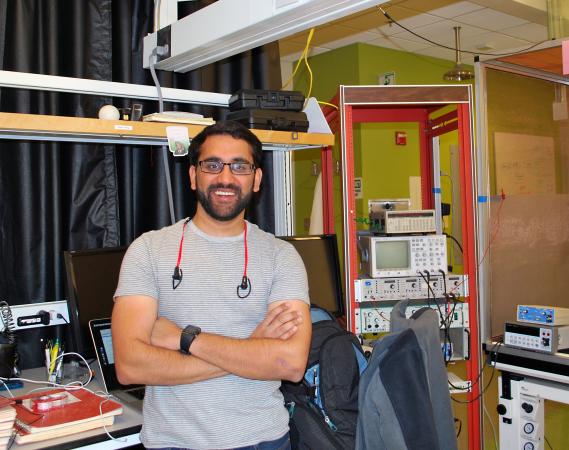Some day, Yogi Patel expects to enjoy the best of both worlds – starting a successful company while enjoying a career in academia. Apparently, ‘some day’ may not be very far off for Patel, a third-year Ph.D. student in the Wallace H. Coulter Department for Biomedical Engineering, who recently won a Young Investigator Award at the IEEE BRAIN Grand Challenges Conference.
The mid-November conference, put on by the Engineering in Medicine and Biology Society (EMBS) of the Institute of Electrical and Electronics Engineers (IEEE), preceded the Society for Neuroscience Annual Meeting in Washington, D.C. The EMBS meeting focused on engineering challenges related to President Obama’s BRAIN (for Brain Research through Advancing Innovative Neurotechnologies) Initiative.
Another goal of the conference was to recognize outstanding young investigators working on innovative research. There were 13 BRAIN Grand Challenge Young Investigator Award winners, students from a range of institutions, including Harvard, Stanford, M.I.T., and one from the Georgia Institute of Technology, Patel, who works in the lab of Robert Butera (professor of electrical and computer engineering who holds a joint appointment in the Coulter Department).
“A lot of the work in our lab is based on peripheral nerve stimulation. Nerves are like cables that let us interact with the world and a lot of our work is focused on answering questions such as, how do you selectively stimulate nerves using electricity, how do you selectively block them using electricity, and what information can we read from them,” says Patel, whose research involves the incorporation of micro-needle technology from Atlanta-based Axion BioSystems with standard nerve cuff electrode technology.
“We’re trying to get close to the source of the signal, which is inside the nerve,” he adds. “The use of micro-needles enables a safe and effective way of recording neural activity from inside the nerve, as opposed to the outside. This may not be a huge leap forward, but it is an incremental leap that helps gain new insights on the types of activity underlying specific neural circuits.”
The idea, essentially, is to improve our ability to read and write to the brain through peripheral nerves. Patel and his fellow researchers are developing technology for better, more precise tools when it comes to recording from the nervous system. “We’re sort of listening in with higher resolution and picking up things we couldn’t pick up before,” says Patel, who also spends time as a mentor in the Petit Scholar program. “The idea is to provide better ways to get better measurements.”
It’s work that he expects will be published early next year and work that will be commercialized, which gets back to the two worlds Patel wants to inhabit – entrepreneur businessman and academic researcher.
“I really want to work at that interface of science and industry – because both worlds are good at their respective things,” he says. “I think that would provide a better way to identify and understand what the rest of the world around us needs.”
Media Contact
Jerry Grillo
Communications Officer II
Parker H. Petit Institute for
Bioengineering and Bioscience
Keywords
Latest BME News
Jo honored for his impact on science and mentorship
The department rises to the top in biomedical engineering programs for undergraduate education.
Commercialization program in Coulter BME announces project teams who will receive support to get their research to market.
Courses in the Wallace H. Coulter Department of Biomedical Engineering are being reformatted to incorporate AI and machine learning so students are prepared for a data-driven biotech sector.
Influenced by her mother's journey in engineering, Sriya Surapaneni hopes to inspire other young women in the field.
Coulter BME Professor Earns Tenure, Eyes Future of Innovation in Health and Medicine
The grant will fund the development of cutting-edge technology that could detect colorectal cancer through a simple breath test
The surgical support device landed Coulter BME its 4th consecutive win for the College of Engineering competition.








